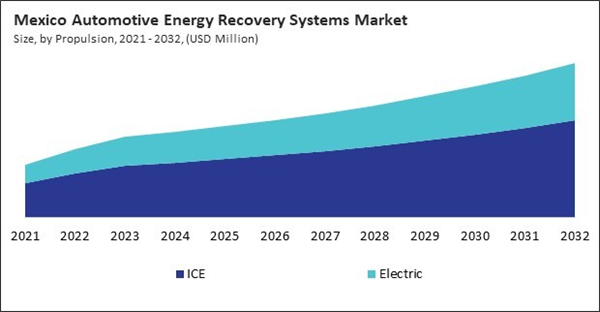The US market dominated the North America Automotive Energy Recovery Systems Market by country in 2024, and is expected to continue to be a dominant market till 2032; thereby, achieving a market value of $4.94 billion by 2032. The Canada market is experiencing a CAGR of 8.5% during 2025-2032. Additionally, the Mexico market is expected to exhibit a CAGR of 7.8% during 2025-2032.
The market has evolved as a pivotal component of modern vehicular engineering, reflecting the global shift towards energy efficiency, reduced emissions, and sustainability in mobility. These systems are designed to recapture and repurpose energy that would otherwise be wasted during various automotive operations such as braking or thermal dissipation. Technologies like regenerative braking, exhaust gas recovery, and thermoelectric generators have become increasingly significant in a range of vehicles, from conventional internal combustion engine models to advanced electric and hybrid vehicles.
A notable trend shaping the automotive energy recovery systems market is the integration of these technologies in electric and hybrid vehicles, where energy efficiency is paramount. Regenerative braking systems, in particular, have become a standard feature in many electric and hybrid models. These systems convert kinetic energy generated during braking into electrical energy, which is then stored in the vehicle’s battery for later use.
The North American automotive energy recovery systems (ERS) market is experiencing significant growth, driven by stringent fuel efficiency and emission regulations, as well as the increasing adoption of electric vehicles (EVs). ERS technologies, such as regenerative braking, exhaust gas recirculation (EGR), and turbocharging, are being integrated into vehicles to enhance performance and reduce environmental impact. The market is projected to grow at a compound annual growth rate (CAGR) of 6.5% from 2023 to 2030, with the U.S., Canada, and Mexico leading the adoption of these systems.
A prominent trend in the North American ERS market is the growing demand for regenerative braking systems, particularly in electric vehicles. These systems capture kinetic energy during braking and convert it into electrical energy, thereby extending the driving range of EVs. Additionally, advancements in turbocharging and EGR technologies are contributing to improved engine efficiency and performance. The integration of these systems is becoming increasingly vital as automakers strive to meet regulatory standards and consumer expectations for fuel-efficient vehicles.
The competitive landscape of the North American ERS market features key players such as Tenneco Inc., Honeywell Corporation, and Cummins Inc., which are actively investing in research and development to enhance their product offerings. Other notable companies include Delphi Technologies (BorgWarner Inc.), Energy Recovery, Stanadyne, Advics, Maxwell Technologies, VALEO SERVICE, and Precision Turbo & Engine. These companies are focusing on innovation, cost optimization, and strategic partnerships to strengthen their market positions and cater to the evolving demands of the automotive industry. In conclusion, the North American ERS market is poised for robust growth, driven by innovation, regulation, and the accelerating shift toward sustainable mobility.
List of Key Companies Profiled
- Robert Bosch GmbH
- Denso Corporation
- Continental AG
- ZF Friedrichshafen AG
- Valeo SA
- Eaton Corporation plc
- Hyundai Motor Company
- Mitsubishi Electric Corporation
- Maxwell Technologies
- Schaeffler AG
Market Report Segmentation
By Propulsion
- ICE
- Electric
By Subsystem
- Regenerative Braking System
- Turbocharger
- Exhaust Gas Recirculation
By Vehicle
- Passenger Cars
- Light Commercial Vehicles
- Heavy Commercial Vehicles
By Country
- US
- Canada
- Mexico
- Rest of North America
Table of Contents
Companies Mentioned
- Robert Bosch GmbH
- Denso Corporation
- Continental AG
- ZF Friedrichshafen AG
- Valeo SA
- Eaton Corporation plc
- Hyundai Motor Company
- Mitsubishi Electric Corporation
- Maxwell Technologies
- Schaeffler AG









